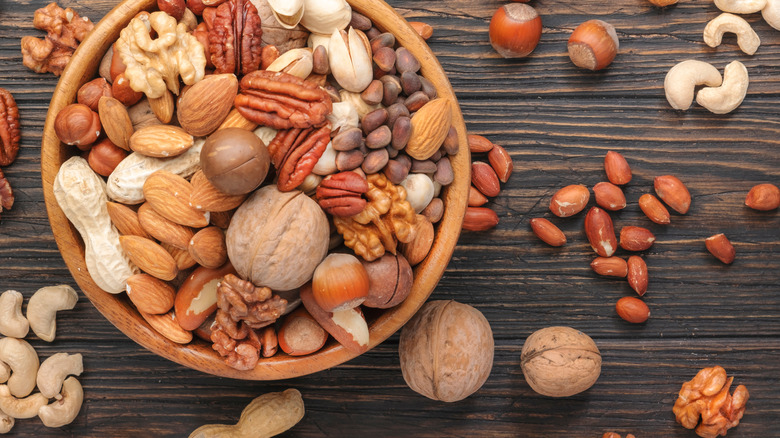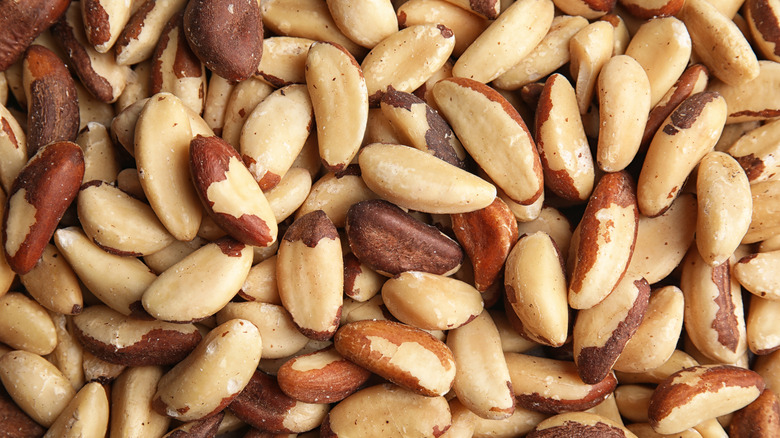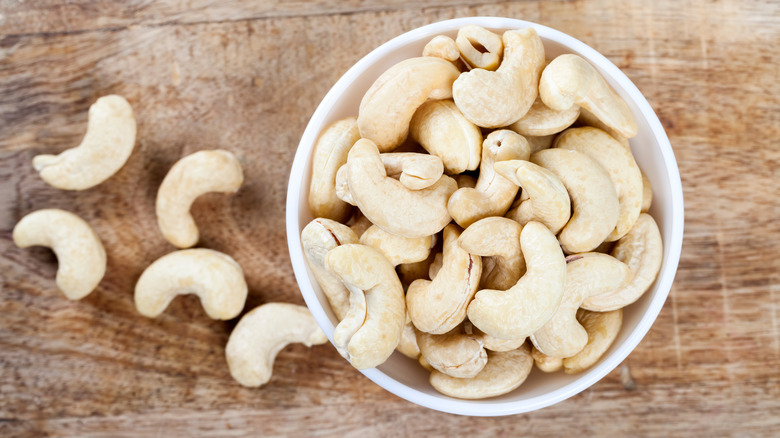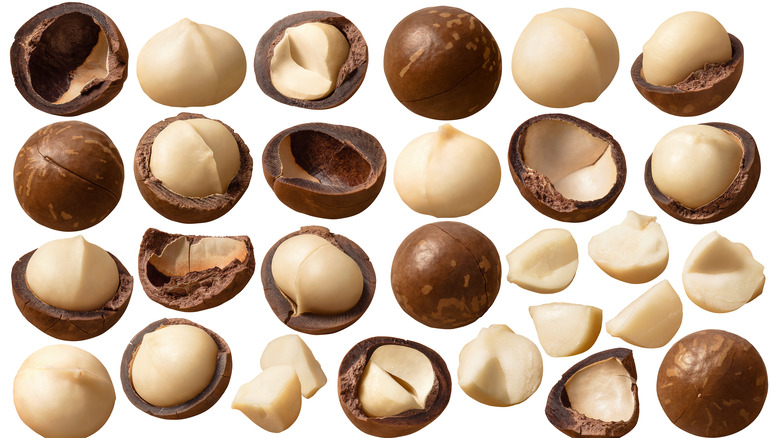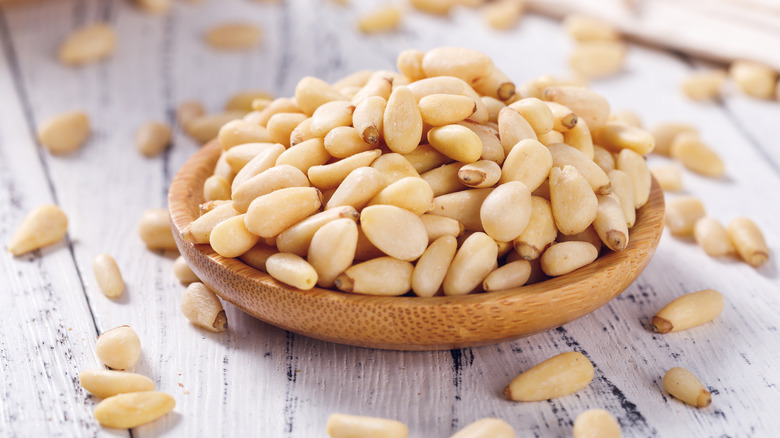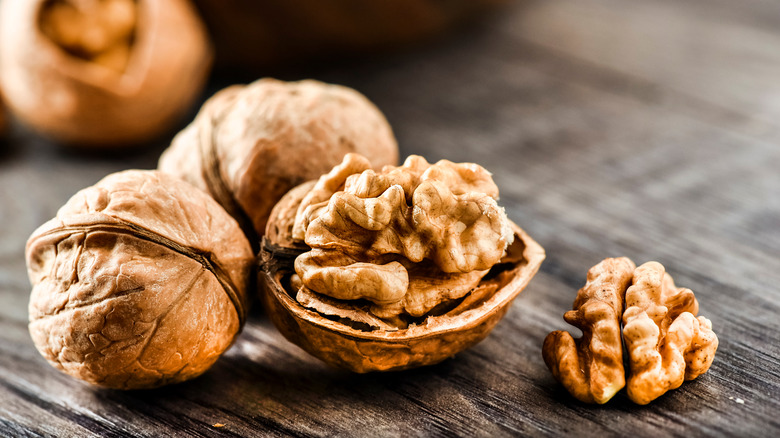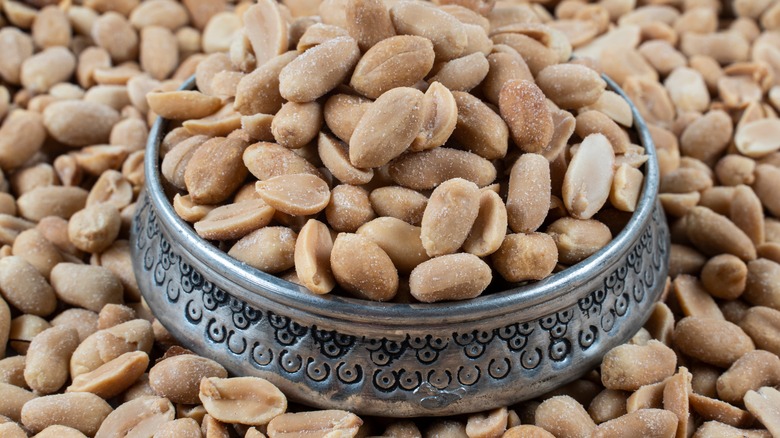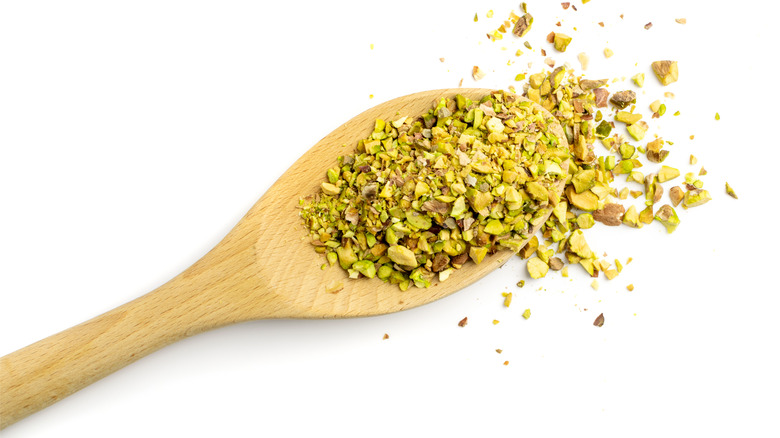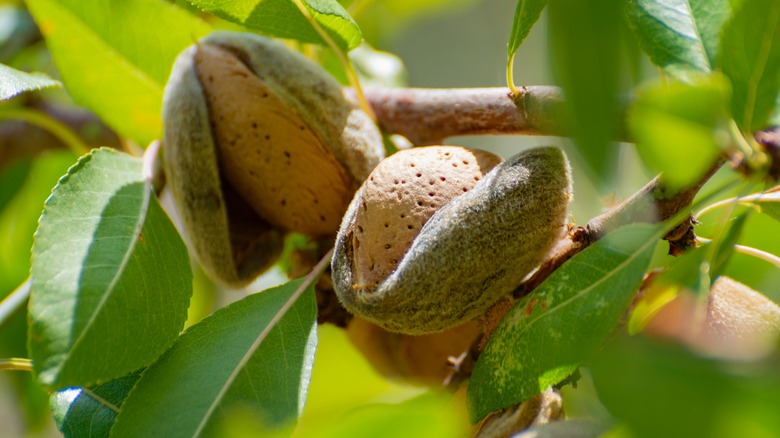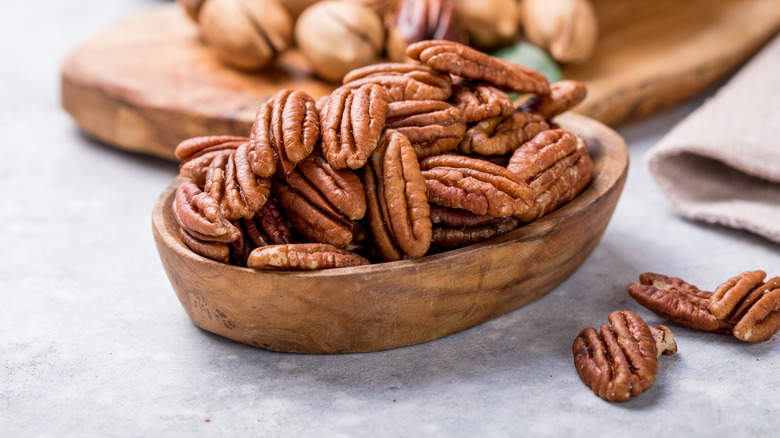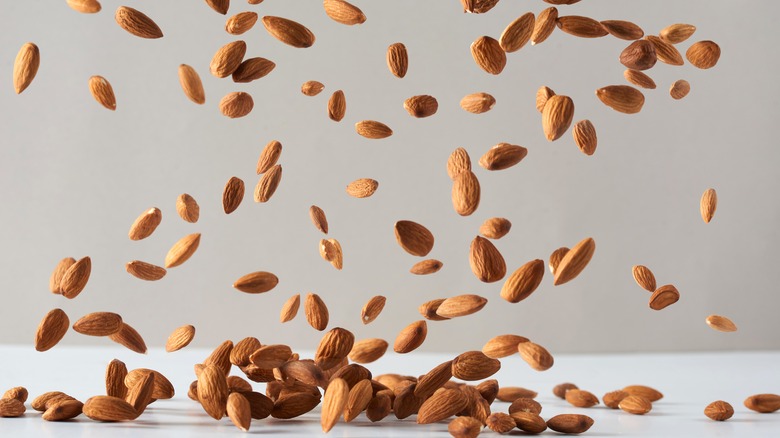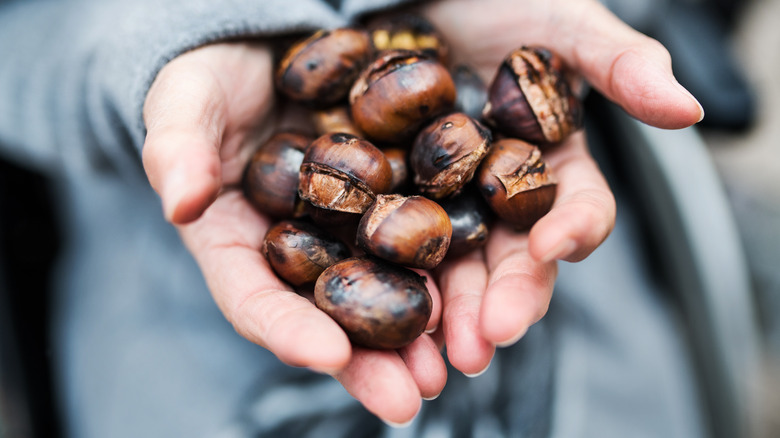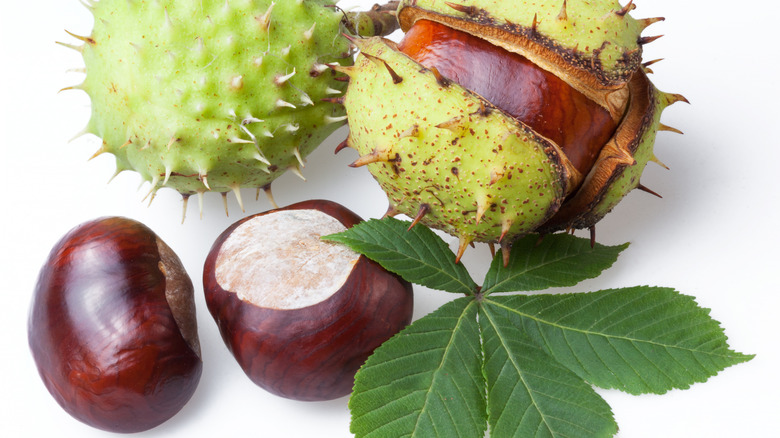6 Nuts You Should Eat More And 6 To Avoid
The consensus is in: Nuts are a healthy habit and a great addition to your daily diet. They're loaded with unsaturated fats, omega-3 fatty acids, and fiber. Unless you have a reason to avoid nuts, such as food allergies, research shows that including a variety of nuts in your diet will produce many benefits. Nuts reduce your risk of heart disease by lowering "bad" LDL cholesterol and triglycerides, and they decrease inflammation and the risk of blood clots (via the Mayo Clinic).
"Generally, all nuts are good sources of healthy monounsaturated fats, protein, fiber, and many different vitamins, minerals, and antioxidants," stated Maggie Michalczyk, a registered dietitian. "Many of us don't get enough fiber, so eating more nuts is an easy way to get more of it," she told Women's Health. But keep it realistic, warns the experts at the Mayo Clinic, "... you could end up canceling out the heart-healthy benefits of nuts if they're covered with chocolate, sugar, or salt."
The evidence is clear that for most people, nuts are pretty awesome. However, there are a few to avoid, and some that can even be toxic. So let's get the whole lowdown on nuts!
Enjoy more Brazil nuts
You've probably eaten a Brazil nut or two from a can of mixed party nuts at some point, and you just didn't know what it was. The large, dense, and oblong nut — which is actually a seed — has a similar texture to a macadamia nut and comes from the Amazonian forests of Brazil, Peru, Colombia, and Ecuador (via Britannica).
Great for thyroid health, these nuts strengthen your immune system, improve cholesterol levels, and reduce inflammation. Brazil nuts are high in selenium, which keeps your thyroid happy and healthy and your immune system humming along. One caveat is that Brazil nuts contain about 175% of the recommended daily allowance for selenium. So you don't want to indulge on too many at a time. "The maximum amount of Brazil nuts you should eat per day is three or you could be headed for selenium toxicity, as the upper limit is 400 micrograms daily," explained registered dietitian Deborah Malkoff-Cohen to The Healthy.
Avoid cashews
We know it seems surprising that these protein-rich, kidney-shaped nuts native to Central and South America and some Caribbean Islands could wind up on our "avoid" list. In short, it's about the ethical conditions in their processing. "More than 60% of the cashews consumed globally are processed in India," revealed The Guardian, by low-wage workers under appalling conditions.
Cashews grow inside of shells on the ends of "pear-shaped drupes called cashew apples," described Healthline. The nut is located inside a hard shell that, in its raw state, contains urushiol, the same caustic substance in poison ivy. If you've ever had the misfortune of getting some urushiol on your skin, you'll know it causes a painful, blistering rash. That's what these workers suffer on a daily basis. De-shelling cashews is labor-intensive and mostly handled manually, reported France 24. A lot of workers don't wear gloves because it slows down production (they're paid by the volume), nor can many even afford them. Urushiol burns and blisters their skin regularly, causing permanent damage. So you have to ask yourself: Is a bag of cashews at your local market worth the human cost?
Go for macadamia nuts
When you think of Hawaii, do macadamia nuts come to mind? You know, the delicious chocolate-covered ones in boxes conveniently stocked at airport gift shops for your flight home. Indigenous to Australia, most of the world's cultivated crop is grown in Hawaii (via Smithsonian Magazine). Macadamia nuts sometimes get a bad rap because they're high in fat and calories. But that's no reason to avoid them. The rich, buttery nut with a delectably creamy texture is really healthy for you. It can even reduce your risk of getting metabolic syndrome, a collection of serious conditions that leads to heart disease, stroke, and type 2 diabetes, and affects one third of adults in the United States.
High in fat doesn't automatically mean bad for you. The macadamia nut is comprised mainly of heart-healthy monounsaturated fat, so not only is it the good and beneficial kind, but it also keeps you feeling fuller longer, explained WebMD. Add to that the macadamia's abundant flavonoids and tocotrienols, which have anti-cancer properties, and you've got yourself one powerhouse nut!
Avoid pine nuts
Pine nuts are slightly sweet, buttery-tasting edible seeds that are popular in Greek and Italian dishes. WebMD noted they're packed with omega-3 fatty acids for brain and heart health, and they stabilize blood-sugar levels and boost energy.
But have you heard of "pine mouth?" It's a temporary "taste disturbance" that leaves you with an intense bitter or metallic aftertaste in your mouth after eating pine nuts. Medically known as dysgeusia or metallogeusia, the strange condition doesn't show up for one to three days after consuming the nuts, reported NSW Food Authority. Worst yet, it reactivates every time you eat or drink, making everything taste awful, and lasts up to two weeks or longer.
Research on the matter suggests the source of the problem is likely a species of non-edible pine nut called Pinus armandii that's exported from specific regions of China and can sometimes make its way into bags of pine nuts that we buy in stores. Controls have been implemented so that particular nut species is minimized (or eliminated) in shipments, but it's still possible to occasionally encounter them.
Become a walnut lover
Enjoyed raw or roasted, the walnut is one of the world's most popular nuts. Loaded with healthy polyunsaturated fatty acids, and anti-inflammatory alpha-linolenic and linoleic acid, Harvard Health Publishing revealed this crinkly brain-shaped nut is a great addition to your diet for lowering "bad" LDL cholesterol and triglycerides, and keeping your blood vessels in good shape. A serving of about 14 walnut halves provide nearly 50% of the daily recommendation for the mineral manganese, which supports bone health, as reported by Health, and is necessary for "collagen production and wound healing."
Adding just 2 ounces of walnuts to a daily diet may also suppress the growth of breast tumors. In a 2019 clinical trial at Marshall University, Dr. W. Elaine Hardman, a professor with the university's Department of Biomedical Sciences and the study leader, told WYMT-TV, "We found that the expression of over 450 different genes changed in directions that would slow the growth or induce the breast cancers to die." She noted that, "Walnuts have a very high level of omega-3 fatty acids... [and] a good level of phytosterols. Between all of these, it adds up to a package that is very beneficial."
Avoid those peanuts
In or out of their shell, salted, roasted, boiled, or raw, or in a spreadable nut butter or sauce, it can't be denied that peanuts are incredibly popular and tasty. "They're a convenient source of protein and come with the added bonus of healthful nutrients, such as antioxidants, iron, magnesium, and fiber," said Ellen Klosz, a nutritionist at Consumer Reports.
Peanuts, which are technically legumes, have nearly twice as much protein as walnuts, are rich in omega-3 fatty acids, and improve blood flow with their high content of the amino acid arginine. However, peanuts are also one of the most common causes of severe allergies, per the Mayo Clinic. These allergies can lead to an overreaction in some people's immune systems that can, within just a few minutes, cause irritating itching, tingling, and hives, or life-threatening anaphylaxis. Between 1995 and 2016, BBC News reported there was "a five-fold increase in peanut allergies in the U.K."
Dr. Scott Sicherer, director of the Elliot and Roslyn Jaffe Food Allergy Institute, told CNBC, "It really is almost an epidemic." Dr. Sicherer was speaking in reference to an Institute study that showed peanut allergies tripling at New York's Mount Sinai hospital from 1997 to 2008. He added, "Every meal, every snack, every party, every social activity — is that food that can hurt me going to be there?"
Eat more pistachios
Pistachios will help keep your eyes healthy! They're packed with "more lutein and zeaxanthin than any other nut," according to the eye-care specialists at Dr. Bishop & Associates in Calgary, Canada. Those important antioxidants keep chronic eye conditions like cataracts at bay and also protect the eyes from age-related macular degeneration, a serious condition that blurs central vision and, per the National Eye Institute, affects 11 million people in the United States alone.
Maya Feller, registered dietitian and founder of Maya Feller Nutrition, told Prevention that, "As one of the highest-protein snack nuts, pistachios are an excellent addition to a well-balanced pattern of eating." Another cool benefit: One serving of pistachios is a generous 49 kernels (via WebMD).
Choose shelled pistachios over unshelled so you don't over-indulge. "They'll take a little longer to eat because you'll have to pry open the shells," registered dietitian Laura Jeffers told the Cleveland Clinic. "The shells also are a great visual reminder of how many you've eaten. This can help to keep you on track with portion size."
Bitter almonds are unsafe to eat
If you've never heard of bitter almonds, you're not alone. What are they, you ask? They're a type of almond from an almond tree, but it's just a different, poisonous variety than the sweet almond that you know and love.
In their unrefined state, bitter almonds are prohibited for commercial sale in the United States because they contain hydrogen cyanide which breaks down into the poison cyanide. And boy, they're potent! Just six raw bitter almonds can poison the average adult, according to Healthline, and 50 could be deadly.
"The bitterness and toxicity of [these] wild almonds come from a compound called amygdalin," explained NPR. Interestingly, the nuts are allowed in Europe, according to The Spruce Eats, and are used in sweets like German Christmas stollen, fruitcakes, and marzipan paste. "Boiling, roasting, or microwaving bitter almonds may help reduce their toxin content and make them safer to eat," noted Healthline. But do you want to risk it? We think it's best to just not mess with them.
Pecans are healthy and tasty
When you're craving pecans, do you get visions of buttery sweet pecan pies or cinnamon-sugar candied treats? Did you know that these nuts, which are the only tree nuts native to North America, are pretty darn good even without all the sugar? Their natural sweetness and crunch not only make them a tasty snack, but incredibly healthy, too. WebMD said pecans are a great source of vitamins A and E, and zinc, all of which support a healthy immune system — and they have more antioxidant flavonoids than any other tree nut.
"According to the USDA, pecans rank as one of the top 15 foods with the highest levels of antioxidants," declared Deborah Malkoff-Cohen to The Healthy. "They are also loaded with vitamins and minerals like manganese, potassium, calcium, iron, magnesium, zinc, and selenium." The United States is the world's leading producer of the pecan, with Georgia, New Mexico, and Texas leading the pack, according to the U.S. Pecan Growers Council.
Interesting historical note: "Pecan" comes from the Native American Algonquin word "pacane" which means "nuts requiring a stone to crack."
Almonds require way too much water to grow
There's no doubt about it: Almonds are a great nut. They taste wonderful and do many beneficial things like reduce breast cancer risks, improve cholesterol levels, and manage blood sugar, per Medical News Today. But the popular almond made our not-so-nice list because, as a crop, it uses the most water. Between 2004 and 2015, it took an "average of 12 liters of water to grow just one Californian almond," CNN reported. About 80% of the world's almonds are grown in California, and farmers are reliant on irrigation and groundwater to produce those crops, revealed a 2017 study.
It can seem like almonds are being unfairly singled out when there are other thirsty California crops, like grapes and alfalfa. But as the Columbia Climate School explained, "Unlike other crops, almonds must be grown year-round, requiring constant water input. Typical crop fields can run fallow for a year and be fine, but almond orchards can't recover the same way ... [a farmer has to] rely on groundwater from wells to provide for the crop." So there it is. A water-dependent crop like almonds is a problem in a state that, as CalMatters described, is facing its driest years on record.
Chestnuts are nutritious
"Chestnuts roasting on an open fire. Jack Frost nipping at your nose," sang the legendary Nat King Cole in the Christmas classic. For many of us, wintry lyrics from "The Christmas Song" or holiday favorites like "A Christmas Carol" may be our only reference to this nostalgic fall and winter treat.
Grill them, boil them, or grind chestnuts into a flour for baking — these nuts can be prepared in a variety of ways. "Roasting chestnuts takes away the raw and bitter flavor," explained The Spruce Eats. Just don't eat them raw because their high level of tannic acid may cause nausea and digestive issues, according to BBC Good Food.
Nutritionally, chestnuts have a rich amount of vitamin C, which WebMD said "makes them unique among nuts." They're also a great source of fiber and are gluten-free, so they're a "healthy choice for people with celiac disease."
"Chestnuts have much more water and very little fat compared to other nuts," Liz Applegate, Ph.D., Department of Nutrition at University of California Davis, told Consumer Reports. "Any way you would use nuts, you could use chestnuts," she added.
Avoid horse chestnuts because they're poisonous
Did you know chestnuts are common ornamental trees that you'll find in many neighborhoods? They're large trees with twisted limbs, whose clusters of white flowers bloom in spring and are followed by "spiny, green seedpods from midsummer through fall," revealed Gardening Know How. The nuts produced by horse chestnut trees look very similar to sweet chestnuts, a similarity that wouldn't be a problem except horse chestnuts aren't edible. In fact, they're poisonous. Horse chestnuts contain the toxin esculin, which can cause severe gastrointestinal illness or even death if consumed (per WebMD).
Michigan State University states that, "Edible chestnuts belong to the genus Castanea and are enclosed in sharp, spine-covered burs. The toxic, inedible horse chestnuts have a fleshy, bumpy husk with a wart-covered appearance. Both horse chestnut and edible chestnuts produce a brown nut, but edible chestnuts always have a tassel or point on the nut."
If you're foraging for chestnuts in the wild, just remember husks that are "shiny" and "spiny" are horse chestnuts, and those are bad, warned The Spruce Eats. "Sweet chestnuts grow in a husk that is covered in what looks like grassy, spiky hair or fur."

